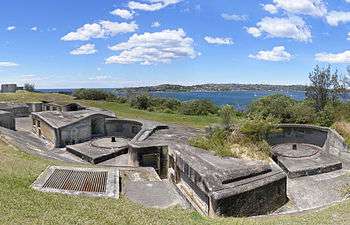Sydney Harbour defences

Coordinates: 33°50′18″S 151°15′21″E / 33.838450°S 151.255930°E Sydney Harbour was protected by coastal batteries and other fixed defences from the early 19th century until the 1960s. These defences were constructed to protect the Australian city of Sydney from attack by enemy warships and submarines.[1]
Pre-Federation defences
Sydney's earliest fortifications were built around Sydney Cove to protect the new colony of Sydney from attacks from non-British ships or convict uprisings. The first gun emplacement was built in 1801 on Middle Head[2] (north of Obelisk Bay) during the Napoleonic wars. More permanent fortifications were built during the first half of the 19th century in response to feared foreign attacks[3] and new threats to the British empire. In 1790 the Dawes Point Battery was meant to be the first line of defence against an attack by the Spanish Empire, Napoleon’s French troops in 1810, and the Russian Pacific Fleet in the 1850s (during the Crimean War). This was part of a line of defences that were concentrated on protecting the inner Harbour, these also appear to have been given a low priority. Construction of Fort Denison began in 1841, though the fort was not completed until 1857.[4][5][6]
Sydney's defences were expanded following the withdrawal (Cardwell Reforms) of British soldiers from Australia during the 1870s. This prompted the construction of four sets of fortifications on Georges Heights and around other parts of the harbour, the Middle Head Fortifications, the Georges Head Battery, the Lower Georges Heights Commanding Position and a smaller fort located on Bradleys Head were constructed during this period and upgraded in the 1880s on the advice of British experts. They were designed to attack enemy ships as they attempted entry into Sydney Harbour. Some of these forts were, at the time, built of an out dated design.

A Submarine Miners' Depot was constructed at Chowder Bay (Georges Head) in the 1880s. In 1888 the site was modified for the latest in harbour defences. The site was a strategic position and considered the best place to observe and fire mines which were laid underwater. Minefields were laid across the main shipping channels of Port Jackson from 1876 to 1922 and a base was built at Chowder Bay for the submarine miners (Clifton Gardens). From Georges Head, miners watched for ships entering the harbour. Their job was to explode the mine closest to an approaching enemy ship. Each underwater mine was attached to an electric cable that ran up the cliff to the firing post.[7][8]
The work of the submarine miner was secretive, technical and dangerous. During a demonstration in 1891, a crowd of several thousand watched as a terrible accident killed four miners and injured another eight.[9] The Submarine Mining Corps was dismantled in 1922.
Sydney's defences were expanded over the last decades of the 19th century and eventually incorporated a fort on Bare Island to defend the approaches to Botany Bay.
World War II
.jpg)
Sydney's defences were not expanded from their pre-Federation condition until the 1920s. During the 1920s a number of well-constructed fortifications were built to protect Sydney. Sydney's defences were further expanded following the outbreak of World War II and were considerably augmented once Japan entered the war. While Sydney's anti-submarine defences were not yet complete at the time of the attack on Sydney Harbour on the night of 31 May 1942, they were successful in sinking two of the three Japanese midget submarines which attempted to enter the Harbour;[7] one submarine fired two torpedoes at a warship, both of which missed, one hitting another ship.
The end of coastal defence
Following the end of the Japanese threat to Australia Sydney's defences were reduced from 1944. The last fortifications were not decommissioned until the 1960s, however. While Sydney is no longer protected by fixed defences, a high proportion of the Australian Defence Force is based within the greater Sydney region and could be called on to protect the city during an emergency. During the 2000 Sydney Olympics security for the Harbour was provided by Special Forces, Navy Clearance Divers and warships.
Current major ADF facilities in Sydney include:
- Navy
- Army
- Victoria Barracks, Sydney (Headquarters Forces Command)
- Holsworthy Barracks
- Steele Barracks Moorebank
- Air Force
References
- ↑ Australian War Memorial http://www.awm.gov.au/diaries/ww2/folder.asp?folder=175 Australian Army war diaries - Sydney Fortress
- ↑ "Sydney's lost fort declared open". DailyTelegraph.com.au. 2010-07-23. Retrieved 2010-07-23.
- ↑ http://www.shfa.nsw.gov.au/uploads/documents/Dawes%20Point%20Excavation.pdf www.shfa.nsw.gov.au/uploads
- ↑ Defence heritage in & around Sydney Harbour
- ↑ Ben Buckler Gun Battery 1893
- ↑ ThePlan
- 1 2 Sydney Harbour Federation Trust Sites - Headland Park
- ↑ Army - The Soldiers' Newspaper
- ↑ http://commons.wikimedia.org/wiki/Image:MiddleGeorgeshedfort0152.JPG
External links
| Wikimedia Commons has media related to Sydney Harbour defences. |
- "THE HARBOUR DEFENCES" The Sydney Morning Herald 13 May 1859: 9
- 1863 map showing defenses Nat. Lib. Aust